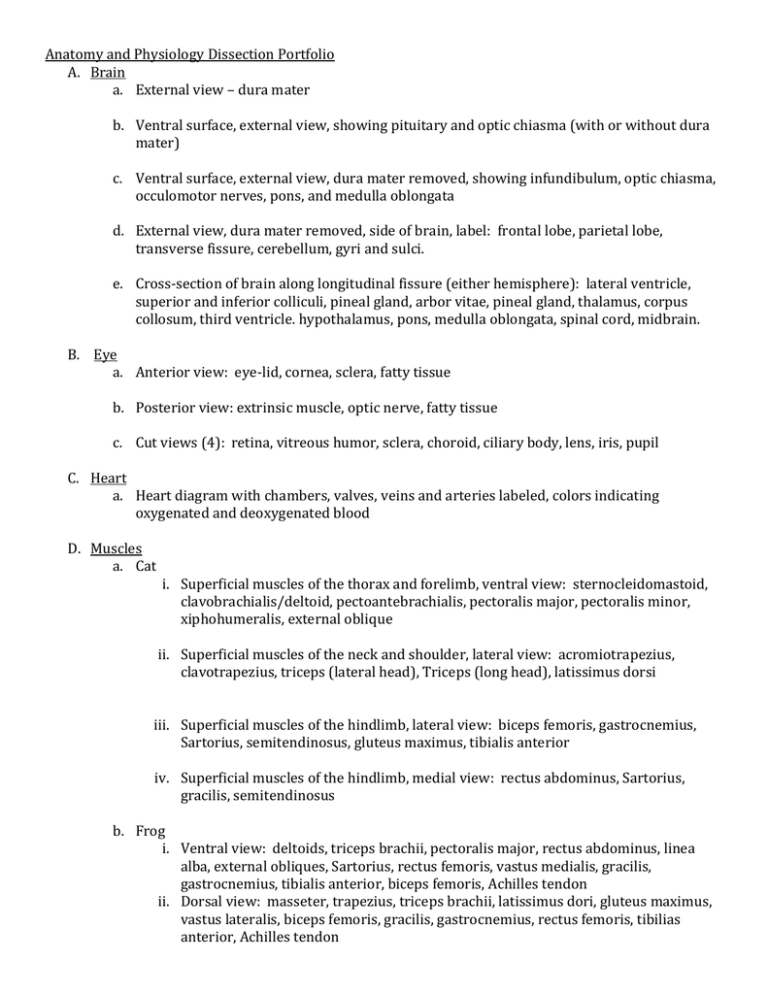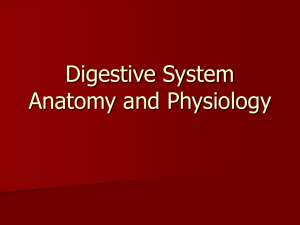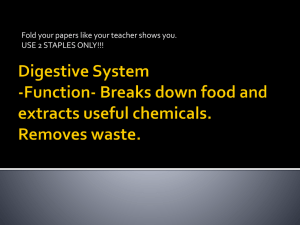Dissection Portfolio
advertisement

Anatomy and Physiology Dissection Portfolio A. Brain a. External view – dura mater b. Ventral surface, external view, showing pituitary and optic chiasma (with or without dura mater) c. Ventral surface, external view, dura mater removed, showing infundibulum, optic chiasma, occulomotor nerves, pons, and medulla oblongata d. External view, dura mater removed, side of brain, label: frontal lobe, parietal lobe, transverse fissure, cerebellum, gyri and sulci. e. Cross-section of brain along longitudinal fissure (either hemisphere): lateral ventricle, superior and inferior colliculi, pineal gland, arbor vitae, pineal gland, thalamus, corpus collosum, third ventricle. hypothalamus, pons, medulla oblongata, spinal cord, midbrain. B. Eye a. Anterior view: eye-lid, cornea, sclera, fatty tissue b. Posterior view: extrinsic muscle, optic nerve, fatty tissue c. Cut views (4): retina, vitreous humor, sclera, choroid, ciliary body, lens, iris, pupil C. Heart a. Heart diagram with chambers, valves, veins and arteries labeled, colors indicating oxygenated and deoxygenated blood D. Muscles a. Cat i. Superficial muscles of the thorax and forelimb, ventral view: sternocleidomastoid, clavobrachialis/deltoid, pectoantebrachialis, pectoralis major, pectoralis minor, xiphohumeralis, external oblique ii. Superficial muscles of the neck and shoulder, lateral view: acromiotrapezius, clavotrapezius, triceps (lateral head), Triceps (long head), latissimus dorsi iii. Superficial muscles of the hindlimb, lateral view: biceps femoris, gastrocnemius, Sartorius, semitendinosus, gluteus maximus, tibialis anterior iv. Superficial muscles of the hindlimb, medial view: rectus abdominus, Sartorius, gracilis, semitendinosus b. Frog i. Ventral view: deltoids, triceps brachii, pectoralis major, rectus abdominus, linea alba, external obliques, Sartorius, rectus femoris, vastus medialis, gracilis, gastrocnemius, tibialis anterior, biceps femoris, Achilles tendon ii. Dorsal view: masseter, trapezius, triceps brachii, latissimus dori, gluteus maximus, vastus lateralis, biceps femoris, gracilis, gastrocnemius, rectus femoris, tibilias anterior, Achilles tendon E. Internal Anatomy (CHOOSE 1) a. Cat i. Cat dissection questions ii. Minimum 3 ventral views: 1. respiratory system (trachea, left lung, right lung, larynx, heart, diaphragm, pulmonary artery, aorta) 2. reproductive/urinary system (testes, urogenital opening, ovary, fallopian tube/uterine horn, urinary bladder, vagina, ureter, kidney) 3. digestive system (greater omentum, body of the stomach, greater and lesser curvature of stomach, fundus of stomach, pyloric and cardiac region of stomach, liver – right medial, right lateral, left medial, left lateral, gall bladder and bile duct, pancreas, spleen, colon – ascending, transverse, descending, cecum, small intestine – duodenum, ileum, jejunum, mesentery, esophagus, rectum/anus) b. Pig i. Pig Dissection questions ii. Pig diagrams as follows: 1. Oral cavity – tongue, hard palate, and soft palate 2. Internal Anatomy (divide between 2 images) -thymus gland, trachea, right lung, left lung, heart, thyroid, diaphragm, liver, gall bladder, stomach, fundus of stomach, body of stomach, small intestine – duodenum, ileum, jejunum, mesentery, esophagus, rectum/anus, pancreas, large intestine, cecum, rectum, spleen, and urinary bladder 3. Urogenital system – kidneys, ureters, urethra F. Comparative Vertebrate Anatomy a. Chart(s)- image – include lungs, heart, diaphragm, liver, stomach, small intestine with length recorded in cm, large intestine, spleen, pancreas, kidneys, testes, ovaries/eggs, bladder, gall bladder (plan to take this picture using actual organs at the end of dissections) b. Triple Venn Diagram – include similarities and differences in the overall anatomy of the frog, pig, and cat with regards to the structures in the chart above and general anatomical characteristics of the three specimens Format is open. (Power point portfolio, notebook portfolio, in a binder, etc. Can use printed real images, printed drawn images, hand drawn images, traced images, etc.) Color code all labels and diagrams and/or use keys. Title all images/views/entries. This document will be converted to a rubric to use for grading. Items will be checked for presence, completion, and accuracy. Overall grade will include a “neatness” aspect (please note – neatness is not the same as “artistic” or “nice handwriting”. Neatness refers more to layout, organization, ease of use, etc.) Final product will be worth 400 total points.








